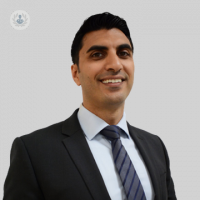An in-depth guide to knee joint preservation
Written by:Experienced consultant orthopaedic surgeon Mr Sam Yasen explains the fundamentals of knee joint preservation, including its history and if he believes that it is better than knee replacement.
What is knee joint preservation and why is it important?
Knee joint preservation is the pursuit of trying to maintain the biological envelope of the knee i.e. to maintain an individual's own knee joint. There are many reasons behind this, not least because we are all living longer and more active lives.

What we are trying to do is get as much time out of our own joints as possible. Since the 1980s and 1990s, there has been a huge expansion in the number of people undergoing knee replacement surgery.
I believe that the modern era of knee surgery is finding surgeons who are interested in joint preservation who can preserve your own knee joint, leaving knee replacements somewhat further down the line, as all of these things have longevity implications.
Another interesting point that is sometimes worth considering is that, even though knee replacements have been around for decades, one of the market-leading knee replacements in the UK is a design that was introduced into the market in 1984. Most of us would not drive a car as old as one from 1984, but that is the kind of technology that goes into knee replacements.
There have been some developments in knee technology over the years but fundamentally, the basic shape of knee replacements and the basic technology behind them have not developed massively. We are looking at biological solutions, even in people in their 60s, 70s and 80s, where we can increase the time that they have from their own knee joint, before we have to think about salvage procedures such as knee replacement.
Why is knee replacement so common?
I believe that knee replacements became common because arthritis is such a frequently-occurring condition in the UK. Knee arthritis is the most common form of arthritis in the UK.
In the 1980s, the modern era of knee replacement surgery came online and there was a big expansion in the technology possible in terms of creating articulating bearings. There was also an improvement in the bearing surfaces.
In modern medicine, we use ultra-high molecular weight polyethene for the bearing. Due to those developments, knee replacements became a very reliable operation for pain improvement. Additionally, due to access to those technologies, knee replacements have become extremely common in the UK, because they address a fundamental problem; knee arthritis.
However, that is not to say that they are the only solution to knee arthritis. As previously mentioned, there are many solutions for joint preservation or more limited forms of replacement that need to be considered.
Is knee joint preservation better than knee replacement?
In my opinion, joint preservation is always a better option than a knee replacement. It's always more meritorious to save the joint and look after an existing joint; to preserve the biology of the patient than to simply chop out the joint and start again with a knee replacement.
As developed as our techniques are in terms of engineering and technologies, we fundamentally have not been able to recreate a normal knee joint in a laboratory with any engineering principles. The other thing to appreciate is that as the knee starts to wear over time, the biomechanical principles around the knee can change, therefore, knee replacements, which are sometimes designed on more normal knees, do not always fit everybody.
A knee replacement is an operation where we replace the joint, but we still have to take care of some of the soft tissues surrounding the knee. If there is a solution with a preservation option, where we can take care of the soft tissues and the joint without violating the knee and having to chop the knee joint out, that will be better.
However, this is not always appropriate, and sometimes the knee is too far gone for preservation techniques.I would encourage anybody who has a knee problem, a knee pathology, to visit surgeons who are skilled in knee preservation techniques as well as knee replacement techniques. Such a qualified surgeon will give the patient the very best advice as to how to maintain the joint, if it is an appropriate option, If not, they will be moved on towards knee replacement.
Who is eligible for knee joint preservation?
In my practice, we consider every individual as potentially eligible for knee joint preservation; it is not an age-based criteria.
For each patient, we consider the merits of trying to preserve the knee, rather than violate that knee with replacement-type operations. We base that on the individual's age, activity profile and aspirations with their joint. We also undertake a biomechanical evaluation through a detailed clinical assessment of the individual and joint, as well as a detailed radiographic examination, i.e. getting X-rays, MRI scans and any associated imaging necessary.
These assessments permit a strong understanding of the nature of that knee joint for that individual. We develop a pathway in terms of whether preservation options may be available, be those injections or injection treatment modalities, moving through to surgical treatments which don't involve replacing the joint.
Surgical options may include reconstructions of ligaments or realignment of the knee joint (knee osteotomy), or a more small print procedure such as transplantation or specialist cartilage work.
Everybody should be viewed as eligible for it until proven otherwise. It’s only in individuals where the knee really is too far gone for those preservation techniques that we begin to think about alternative options, such as a unicompartmental or full joint replacement.
If you would like to book a consultation with Mr Yasen, do not hesitate to do so through his Top Doctors profile today.


